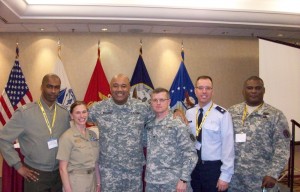By BG Darryl A. Williams, WTC Commander
Today, we celebrate Independence Day—our Nation’s 235th birthday. As we enjoy all the traditions and pleasures of this uniquely American holiday, I would hope that every American would take a few minutes to remember those who have done so much to secure and safeguard our independence throughout our history. Without their sacrifice we would not be a free people reaping the benefits of the gift of freedom for which they paid so dearly.
Today, more than 200,000 Americans in uniform are deployed in harm’s way, protecting us. Their steadfast service is a continual reminder that defending our nation is a pursuit that requires persistent, diligent and disciplined commitment each and every day. Our men and women in uniform are always on watch, whether it be in Afghanistan, Iraq or a dusty lonely outpost halfway across the globe.
America’s military consists of about one-half of one percent of the American population! Yes, less than one in every 100 Americans wear the uniform of an active or reserve component member. What a burden each carries on behalf of every single American.
We can’t thank these heroes enough for their service.
I am privileged and honored to serve as the commander of the Warrior Transition Command, a command that touches and impacts the lives of so many of our wounded, ill and injured Soldiers. As we all team together for our Soldiers, Veterans and Families, I think of the essential services the men and women of WTC—military and civilian—provide for our wounded, ill and injured. It makes me pause and reflect. The nurse, the squad leader, the doctor, the platoon sergeant, and the other professionals create one team to support our wounded, ill, and injured Soldiers.
In America, we love to celebrate our nation’s birth, independence and freedom. From the hamburgers and hot dogs on the grill to the potato salad that adorns most backyard picnic tables it’s the sounds, smells and sights I love so much. And who can’t be touched by the parades in small and large towns filled with beautiful red white and blue colors that drape lamp posts and parade stands across our land. But my personal favorites are the small American flags that our Veteran Service Organizations, Boy Scouts and thousands of other groups plant in the ground of yards and cemeteries.
And who isn’t moved by our Veterans from past wars and conflicts raising the American flag in their yard followed by an enthusiastic salute.
Man, that really gets me!
The emotions I feel from such symbols can’t be totally explained but I feel such a sense of patriotism when I see our wonderful country come together and celebrate freedom. When I see Americans of all colors, creeds, shapes and sizes celebrate our Independence, I stand up a little taller and walk with a newfound purpose as my heart swells a bit. My eyes mist and I get a chill. No doubt, you’ve felt it too—I know it isn’t unique to me!
Please remember—always remember—that freedom isn’t free. The gains of 235 years can be quickly lost if we do not maintain our steadfast commitment and resolve. The responsibility it takes to retain the rights our Citizen Soldiers throughout our history fought so hard to attain can be lost. Those Minutemen who rose with their muskets, pitchforks and grit against a formidable and seemingly unbeatable military force are an enduring example for today’s service members.
Today we are engaged in a struggle as great as any America has faced throughout her long and honored history. It is a struggle every bit as much a fight for freedom as the war that was fought in 1776. Once again it is a battle for humanity, for the rights of all people—not just Americans—to live in a world free of terror and fear.
God bless and happy birthday America.








